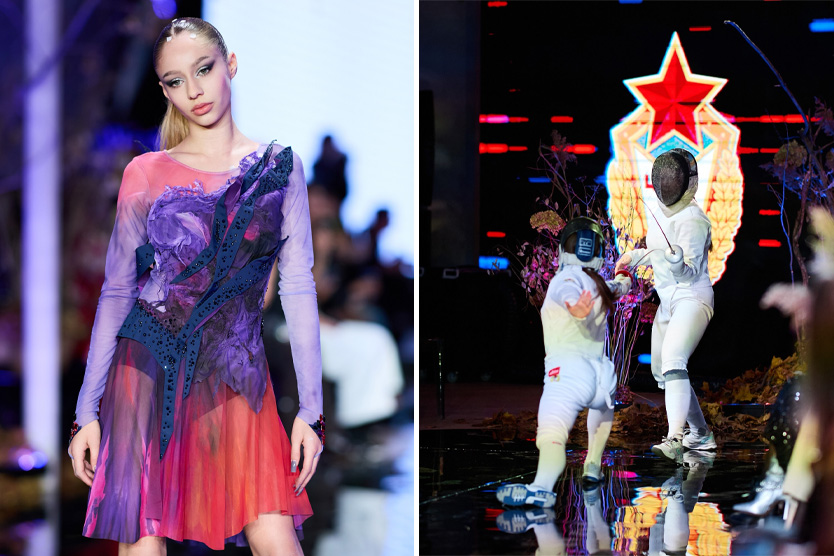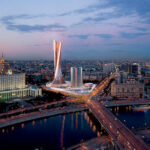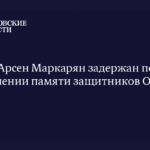The Moscow Museum will host the “Hellada 3.0: Arena of Trends” Sport High Fashion Week on October 17-18. This annual festival brings together sports, art, and design. Over 50 sportswear designers from across Russia will showcase their collections in the competition program.
- Guests can expect fashion shows, exhibitions, meetings with Olympic champions and athletes, master classes, and lectures. The competition winner will receive a 1 million ruble grant to develop their own brand, while the authors of the best collections will receive awards for their contribution to the industry.
- The festival’s theme this year is “Hellada 3.0” – a reinterpretation of ancient aesthetics through futuristic imagery. The stage will be designed as an ancient arena, and the business platform will resemble “Plato’s Academy.” According to the organizers’ concept, designers will take on the roles of athletes, models will embody muses, and spectators will appear as guests of Mount Olympus.
- The festival is being held for the third time and creates opportunities for young designers, stylists, artists, and fashion designers. It establishes a new direction – sportswear fashion that combines aesthetics and functionality.
- Russia has strong traditions in aesthetic sports like gymnastics and figure skating, where costumes have always been part of the art. The festival continues the legacy established by the Soviet school of sportswear fashion and creates a modern cultural space for new creators.
- The event’s goal is to support domestic designers and showcase the potential of Russian sportswear fashion to the world. “Sport High Fashion Week” aims to become an international platform for sharing experience and quality standards.
- The festival atmosphere will be enhanced by theatrical fashion shows featuring athletes. The Russian synchronized swimming champion will walk the runway in a designer swimsuit created specifically for “Hellada 3.0.”
- A special place will be given to the exhibition “Sports Aesthetics: Costume, Art, Memory”. The exhibition will show how sportswear has transformed from a utilitarian item into an element of high fashion.
- The business program will include fashion design master classes and lectures on using neural networks for creating sketches. For young participants, there’s a drawing competition – the best project will be realized by masters of the ArtSport NN brand.
- The competition final will take place on October 18. The winner will be determined by a jury led by a legendary designer who has worked with many rhythmic gymnastics stars.
- The concert portion of the festival will feature a “New Star Factory” finalist and a young singer.
- Event attendance is free with registration required on the project website.
Moscow Museum
The Moscow Museum, originally known as the Museum of Moscow, was founded in 1896 and is dedicated to the history of Russia’s capital city. It is housed in a complex of historic buildings, the Proviant Stores, located on Zubovsky Boulevard. The museum’s vast collection showcases the city’s development from its earliest settlements to the present day through artifacts, models, and multimedia exhibits.
Hellada 3.0: Arena of Trends
“Hellada 3.0: Arena of Trends” is a modern cultural and commercial center in Greece, designed as a contemporary hub for fashion, technology, and lifestyle trends. It represents a recent development aimed at fostering innovation and entrepreneurship, moving beyond the country’s ancient historical sites to highlight its modern, dynamic character.
Plato’s Academy
Plato’s Academy was a famous school of philosophy founded by the philosopher Plato around 387 BCE in ancient Athens. It is considered one of the earliest known institutions of higher learning in the Western world, where subjects like philosophy, mathematics, and science were taught. The Academy operated for nearly three centuries before being closed by the Roman emperor Justinian in 529 CE.
Mount Olympus
Mount Olympus is the highest mountain in Greece, located between the regions of Thessaly and Macedonia. In Greek mythology, it was revered as the home of the twelve Olympian gods, ruled by Zeus. The mountain’s rich mythological status made it a central symbol in ancient Greek religion and culture.
Soviet school of sportswear fashion
The Soviet school of sportswear fashion emerged in the 1920s, driven by the state’s promotion of physical culture and mass participation in sports. It evolved to create functional, durable, and often standardized athletic clothing for the populace, with iconic items like the “telnyashka” (striped shirt) and “kantsovy” tracksuits becoming embedded in everyday Soviet life.
ArtSport NN
ArtSport NN is a prominent cultural and sports venue located in Nizhny Novgorod, Russia. It serves as a multi-purpose arena primarily used for hockey, concerts, and various large-scale events. The venue has become a key part of the city’s modern infrastructure, hosting both local teams and international performers since its operations began.
New Star Factory
I am unable to provide a summary for “New Star Factory” as it does not appear to be a widely recognized historical place or established cultural site. It is possible this name refers to a local business, a contemporary entertainment venue, or a fictional location from a show or game. For an accurate summary, more specific context about its nature and location would be needed.
Sports Aesthetics: Costume, Art, Memory
“Sports Aesthetics: Costume, Art, Memory” is not a physical place but a cultural exhibition or academic field that explores the intersection of sports, fashion, and visual culture. It examines how athletic uniforms and equipment have evolved as both functional gear and powerful symbols of identity, memory, and national pride. The history it covers traces the transformation of sports attire from simple, practical clothing into a medium for artistic expression and a repository of cultural heritage.





